Abstract
In this paper, a novel parallel factor (PARAFAC) model for processing the nested vector-sensor array is proposed. It is first shown that a nested vector-sensor array can be divided into multiple nested scalar-sensor subarrays. By means of the autocorrelation matrices of the measurements of these subarrays and the cross-correlation matrices among them, it is then demonstrated that these subarrays can be transformed into virtual scalar-sensor uniform linear arrays (ULAs). When the measurement matrices of these scalar-sensor ULAs are combined to form a third-order tensor, a novel PARAFAC model is obtained, which corresponds to a longer vector-sensor ULA and includes all of the measurements of the difference co-array constructed from the original nested vector-sensor array. Analyses show that the proposed PARAFAC model can fully use all of the measurements of the difference co-array, instead of its partial measurements as the reported models do in literature. It implies that all of the measurements of the difference co-array can be fully exploited to do the 2-D direction of arrival (DOA) and polarization parameter estimation effectively by a PARAFAC decomposition method so that both the better estimation performance and slightly improved identifiability are achieved. Simulation results confirm the efficiency of the proposed model.
1. Introduction
The vector sensors, e.g., the acoustic [1] and electromagnetic (EM) [2] ones, can record two to six signal components on a collocated sensor. Hence, the redundancy of signals is one of their advantages. By means of a single polarized vector sensor, Yuan in [3] achieved estimating the direction of arrival (DOA) and the polarization of a completely-polarized polynomial-phase signal of an arbitrary degree. In [4,5], the vector sensors were applied to the target localization. A multiple-input multiple-output (MIMO) array system with the EM vector antennas was presented in [6]. However, all these contributions utilized the so-called “long-vector” approach which could destroy the multidimensional structure of the received signals of vector sensors [7]. In order to fully utilize the multidimensional structure information of vector sensors, a tensor decomposition method for effectively estimating vector-sensor-based signal parameters was proposed in [8].
The topic of source localization with fewer sensors than sources has received extensive attention in recent years. One of the most effective methods for doing that is to construct a virtual array, i.e., the difference co-array from the physical array covariance, with a higher degrees-of-freedom (DOF) than that of the physical array. One of the typical schemes reported in literature is the nested array [9]. The nested array can achieve O(N2) DOF with N sensors when two or more uniform linear arrays (ULAs) with increasing inter-element spacing are suitably combined to form a difference co-array. The nested array theory has been applied to various scenarios, e.g., the off-grid DOA estimations [10], two-dimensional arrays [11], conformal arrays [12], L-shaped nested arrays [13,14], adaptive beamforming [15], wideband signals [16], distributed sources [17], and spatial-temporal nested sampling [18].
For utilizing the 1-D array to achieve the 2-D DOA estimation and resolve significantly more sources than the actual number of physical sensors, the nested vector-sensor array was proposed in [19]. Since the data structure of the nested vector-sensor array is more complex, the multilinear algebra, that is the tensor algebra [20], was utilized in [19]. Although the measurements of the nested vector-sensor array in [19] were modeled as a tensor, the ones of the difference co-array constructed from the nested vector-sensor array were described as a matrix. As a result, 1/M (M is the components number in a vector sensor) observation data of the difference co-array were only exploited, which means that the redundancy of signals offered by the vector sensors has not been taken full advantage. Furthermore, for achieving the 2-D DOA and polarization parameter estimation, it has to apply at least two-way spectral peak searching, maybe up to four-way, to the difference co-array covariance tensor as shown in [19], which implies that the high computational complexity has to be paid.
In order to take full advantage of the redundancy of signals offered by the nested vector-sensor array and avoid the multidimensional spectrum peak search, a novel parallel factor (PARAFAC) model for processing such an array is proposed in this paper. Analyses show that by dividing the measurement tenor of the nested vector-sensor array into matrices, we can obtain M matrix models corresponding to M independent nested scalar-sensor subarrays, each of which is constructed from the components of the N vector sensors with the same orientation. From the autocorrelation matrices of the received signals of the M subarrays and cross-correlation matrices among them, M measurement matrices corresponding to M virtual ULAs with scalar sensors are obtained. Since these virtual scalar-sensor ULAs enjoy the same spatial and equivalent temporal diversity spaces, we can combine them to form a new virtual ULA with vector sensors and M snapshots, and model it as a tensor with a PARAFAC decomposition form. In this way, all of the measurements from the difference co-array of the original nested vector-sensor array are described as a PARAFAC model, instead of a matrix one reported in [19]. It also means that these measurements are fully exploited to improve the estimation performance and the identifiability of the difference co-array when a PARAFAC decomposition method is applied to our model. Simulation results confirm the correctness of the analytical results and verify the effectiveness of the proposed model.
The reminders of the paper are organized as follows. In Section 2, three tensor operators required by this paper are simply reviewed. The PARAFAC model with an explicit diversity structure for a nested vector-sensor array is given in Section 3. In Section 4, the novel PARAFAC model for the difference co-array of the nested vector-sensor array is proposed. How to employ the proposed model to achieve the source localization and polarization estimation is reported in Section 5. Simulation results are presented in Section 6. Section 7 concludes this paper.
Notations: , , , , and denote conjugation, transpose, outer product, Kronecker product, and Khatri-Rao product, respectively.
2. Tensor Algebra Prerequisites
For the readers’ convenience, some most relevant tensor operations are reviewed here. For a complete introduction to them, please refer to [20,21,22].
Definition 1.
(The PARAFAC decomposition): Letbe a Nth-order tensor, then the PARAFAC decomposition ofis a weighted sum of rank-1 tensors, defined as
whereis a constant coefficient,is a vector of size().
The so-called “factor matrices” of the decompositionforare written as.
Definition 2.
(The tensor contraction): Given,,,, and, then the contraction betweenandin the pth and qth modes is denoted bywith its element as
Definition 3.
(The matricization of the PARAFAC decomposition): For ath-order PARAFAC modelwhereis a constant coefficient and(), let the ordered setsandbe a partitioning of the dimensions, then the matricization of, denoted bywithand, is defined as
whereand.
3. Tensor Model for a Nested Vector-Sensor Array
In this section, we will arrange the measurements and noise from all of the components of the sensors in the nested vector-sensor array into a third-order tensor.
As shown in Figure 1, a 2-level nested vector-sensor array containing vector-sensors in the inner ULA and vector sensors in the outer ULA is taken into consideration. Without loss of generality, assume that all of the vector sensors in the array are located along z-axis, the total number of sensors is even, , the inter-sensor spacing in the inner ULA is one half of the signal wavelength, i.e., , and the one in the outer ULA is . Each vector sensor contains M components. There are K narrowband far-field uncorrelated signals impinge on the array from the distinct directions with elevation and azimuth angles , where and . Let be the direction cosine of the kth source, and be the position vector of the th sensor. In this way, the measurement matrix of the array at time t is given as [19]
where is the spatial steering vector, is the kth source signal, is the corresponding noise matrix, T () is the number of snapshots, and is the spatial response vector of the vector sensor located at the origin. Note that for the acoustic vector sensors [1] and , while for the electromagnetic vector sensors [2] and
where and are the polarization auxiliary and phase difference angles of the source, respectively.

Figure 1.
A 2-level nested vector-sensor array.
Based on Equation (4), let () be the tth frontal slice [20] of the tensor , then can be expressed as
where is the kth signal vector, and is the corresponding noise tensor whose tth frontal slice is . Obviously, this tensor model is of an explicit diversity structure. More precisely, the three dimensions of are respectively corresponding to the spatial, polarized, and temporal diversity spaces of a nested vector-sensor array. Comparing the signal model of Equation (10) in [19] with Equation (5) for the same nested vector-sensor array, one can see that unlike the matrix model in [19] the tensor model in Equation (5) contains all the measurements of the array, and more importantly it is of a natural PARAFAC decomposition form as Equation (1). It means that the PARAFAC decomposition can be applied to for estimating the , , and if required.
4. New Model for the Difference Co-Array
Similar to Equation (5), here a PARAFAC model for the difference co-array constructed from the array covariance of the nested vector-sensor array will be given.
Let and be the mth lateral slices of and [20], respectively, then can be given by
where is the th entry of .
Comparing Equation (5) with Equation (6), one can find that for can be viewed as the measurement matrices of M independent nested scalar-sensor subarrays, each of which is constructed from the components of the N vector sensors with the same orientation.
Utilizing the Definition 2, one can get the second-order automoments, i.e., autocorrelation matrices, of the M nested scalar-sensor subarrays as:
where and are the signal and noise powers, respectively, and is the identity matrix.
Similarly, the second-order cross-moments, i.e., cross-correlation matrices, among the mth subarray and the others are given as:
Based on Equations (7) and (8), let be the th () frontal slice of a tensor , then can be written as:
where with the elements
Applying the Definition 1 with and to we have
where . Note that is the spatial steering vector of the original nested array with N sensors, hence by removing the repeated rows and sorting the remaining ones in , one can obtain the spatial steering vector of a virtual ULA with sensors [9]. Similarly, according to in Equation (10) we remove the repeated rows and sort the remaining ones in , then we have:
where:
Let , and , then can be rewritten as
Comparing Equation (6) with Equation (13), one can see that if is taken as the equivalent signal vector, then can be viewed as the measurement matrix of a virtual ULA with scalar sensors. Note that contains M equivalent snapshots. Hence, from the M nested subarrays with N scalar sensors as shown in Equation (6), one can construct M virtual ULAs with scalar sensors as shown in Equation (13).
Since the M scalar-sensor ULAs contain the same spatial () and equivalent temporal () diversity spaces as shown in Equation (13), for can be arranged into a three-way tensor denoted by , where is the th () lateral slices of . Let be the th () lateral slices of , then can be expressed as
Comparing Equation (14) with Equation (5), one can find that the proposed PARAFAC model corresponds to a virtual ULA with vector sensors and snapshots. From Equations (7) and (8), it is easy to verify that consists of all the measurements of the difference co-array constructed from the original nested vector-sensor array. Hence, we call in Equation (14) as the PARAFAC model for the difference co-array of a nested vector-sensor array, which will be used to improve the performance of the nested vector-sensor array.
Remark 1.
As shown in Equation (14), a virtual ULA withvector sensors and M snapshots has been constructed from the original nested array with N vector sensors. It should be noted that such a virtual vector-sensor ULA can be considered as the complete difference co-array of the nested vector-sensor array, becausecontains all of the data in the array covariance of the original nested array. In contrast, 1/M data, corresponding to a single snapshot, from the array covariance of the original nested array are only used for constructing the virtual vector-sensor ULA as given in [19]. Furthermore, the virtual vector-sensor ULA constructed by [19] was modeled as a matrix, whereas our virtual vector-sensor ULA is modeled as a tensor with a PARAFAC decomposition form. Based on the proposed model in Equation (14), a significant performance improvement can, hence, be expected.
5. 2-D DOA and Polarization Parameter Estimation
5.1. Tensor-Based Spatial Smoothing
In Equation (14), can be viewed as the kth equivalent signal vector with M samples. Hence, before estimating 2-D DOAs and polarization parameters of sources, one can employ the tensor-based spatial smoothing technique [23] to increase the equivalent snapshots so that the identifiability of the virtual vector-sensor ULA can be increased. To this end, we divide the matrix (13) into overlapping sub-matrices of size , where the th () sub-matrix corresponding to the th to ()th rows of is expressed as:
where is corresponding to the th to th elements of . Since is the spatial steering vector of the virtual ULA expressed as (12), one can denote as:
where is corresponding to the first to th elements of .
Now, we rewrite as:
Let and be the th () frontal slices of the tensors and , respectively, then can be given by
where .
Applying the Definition 3 with and to we have
where .
Note that for can be arranged into a three-way tensor denoted by . Assuming and whose mth () lateral slices are and , respectively, we have
Comparing Equation (14) with Equation (20), one can see that a longer ULA with vector sensors and M snapshots is transformed into the short one with vector sensors and snapshots. Its purpose is to overcome the problems that may occur when the source matrix is rank deficient. Hence, similar to the traditional spatial smoothing technique, the goal of this way here is to obtain a new full rank source signal matrix at the expense of a reduced effective aperture.
5.2. Uniqueness
In Equation (20) is the kth equivalent signal vector with samples, and its corresponding factor matrix (i.e., the new source signal matrix) is:
Let , , , and be the factor matrices corresponding to , , and , respectively. From we have:
Similar to [24,25,26], we also assume here that the K sources are uncorrelated and the source DOA pairs are restricted to satisfy the condition given by Theorem 4 in [12] so that the signal matrix () with a full column rank is guaranteed. Under these assumptions and considering the Vandermonde structures of and , we have and , where represents the Kruskal rank [20] of the matrix , which equals to the largest integer such that any set of columns of is linearly independent.
Since and its corresponding factor matrix is , we can rewrite as:
Obviously, the Kruskal rank of is depending on the (or ). So we have in general for electromagnetic vector sensors [27] and for acoustic vector sensors [28].
Using the Lemma 3.1 in [29], we have:
The PARAFAC model is essentially unique, if [20]
According to Equation (25), for the case where (corresponding to ) and (corresponding to ), the uniqueness result of the proposed model can be given as follows
Taking into consideration and using Equation (26), we have
Note that is equal to the vector sensor number of the longer vector-sensor ULA, i.e., . Hence, Equation (27) can be rewritten as
Based on Equations (26) and (28), we have
Thus, applying the PARAFAC decomposition to the proposed under the conditions Equations (28) and (29), one can identify up to sources (corresponding to DOF) for the nested array with N electromagnetic vector sensors, and up to sources (corresponding to DOF) for the one with N acoustic vector sensors. In contrast, the method in [19] could resolve sources (corresponding to DOF) regardless of the electromagnetic vector sensors or acoustic ones.
Utilizing the MATLAB function “cp3_alsls” provided by [30] to carry out the PARAFAC decomposition for , one can get the estimations , and . Then, the estimations can be obtained from , and , , and can be obtained from as done in [8].
Moreover, from Equation (20), it can be seen that both the PARAFAC decomposition and the classical subspace methods can be employed to get the expected estimates. Let () be the tth frontal slice of , which can be viewed as the tth measurement matrix of the vector-sensor ULA, then the array covariance tensor is
Based on Equation (29), one can apply the SORTE method [31] to detect the source number, and use the Tensor-MUSIC method described in detail in [19], to achieve 2-D DOA and polarization parameter estimation. In short, for the source localization and polarization estimation, the proposed model can be employed to do those with both the PARAFAC decomposition and Tensor-MUSIC. It should, however, be noted that, using the PARAFAC decomposition to do estimates, one cannot only avoid the multidimensional spectrum peak search but also improve the estimate performance because the data structure (e.g., Vandermonde) of is capitalized on enhancing the estimation accuracy further [23,32].
Remark 2.
Compared to the method in [19], the identifiability of the proposed one is slightly improved. It should be emphasized that, since the proposedis a PARAFAC model, one can employ the PARAFAC decomposition to achieve the 2-D DOA and polarization parameter estimation. It implies that the 2-way spectral peak searching, maybe up to four-way when necessary, for the method in [19], can at least be avoided. Furthermore, the data structure (e.g., Vandermonde) in can be used by our model to improve the estimate performance further.
5.3. Summary of the Proposed Method
The overall procedure of the proposed method is summarized in Table 1.

Table 1.
The overall procedure of the proposed method.
6. Numerical Examples
In this section, we will use numerical examples to show the effectiveness of our PARAFAC model and its analytical results. In all the simulations, except for the examples 6.5 and 6.6, the two-level nested array containing EM vector sensors, with , is considered. Based on this nested vector-sensor array, we set and according to Equation (29) so that the proposed model can yield 15 DOF. In contrast, the model in [19] can yield 12 DOF. Moreover, the performance of a physical ULA with EM vector sensors whose DOF is 12 as well is taken as a benchmark. Notice that for the proposed model the PARAFAC decomposition is employed. For the model in [19] and the benchmark, the Tensor-MUSIC is used, where the angular resolution is fixed to .
6.1. Identifiability of the Proposed Model
In order to verify that the proposed model can handle 15 DOF, 14 sources with the impinging directions , polarization parameters and , for are taken into consideration. The signal-to-noise ratio (SNR) and the number of snapshots are set to 30 dB and 1000, respectively. The simulation results obtained via 100 Monte Carlo trials are shown in Figure 2. It can be seen from Figure 2 that the proposed model can effectively handle the 14 sources, which cannot be done by both the model in [19] and the benchmark.
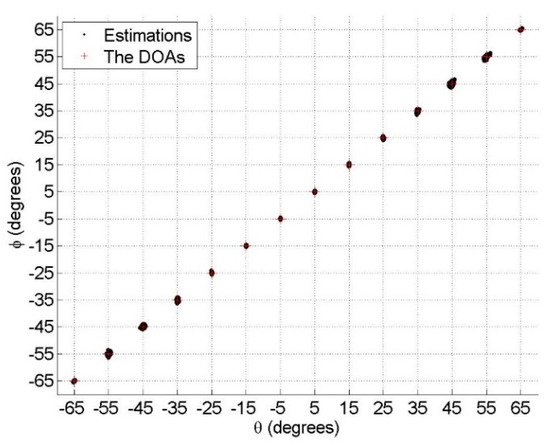
Figure 2.
Estimations of 14 sources.
6.2. Resolution Performance
Assume that there are two close sources in a surveillance region. The two sources with the 2D DOAs as and and polarization parameters as impinge on our nested vector-sensor array. For the purpose of intuitive demonstration, the polarization parameters are assumed to be known. The estimation results with the SNR = 20 dB and T = 500 are shown in Figure 3, Figure 4 and Figure 5, respectively. From these figures, one can see that the method in [19] cannot distinguish the two close sources, while both the proposed method and the benchmark can resolve them. It must be emphasized that 12 physical vector sensors are used by the benchmark, whereas six are used by the proposed method.
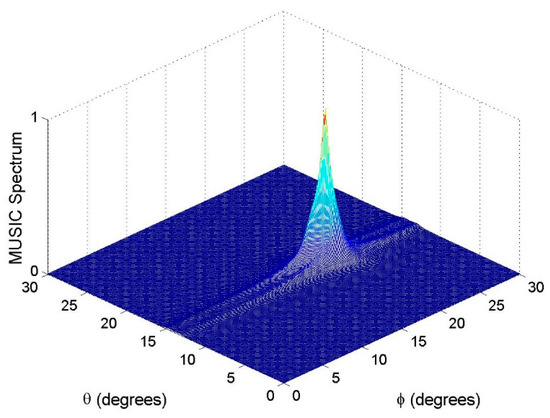
Figure 3.
MUSIC spectrum of the method in [19].
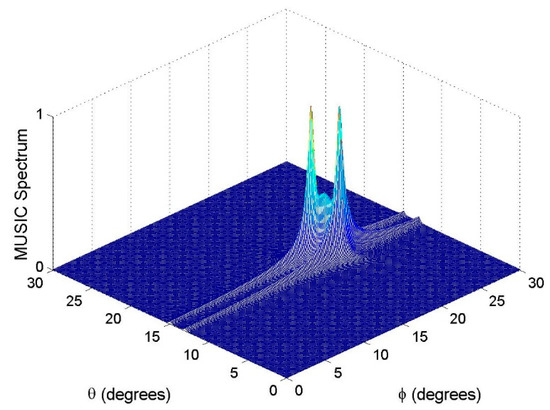
Figure 4.
MUSIC spectrum of the benchmark.
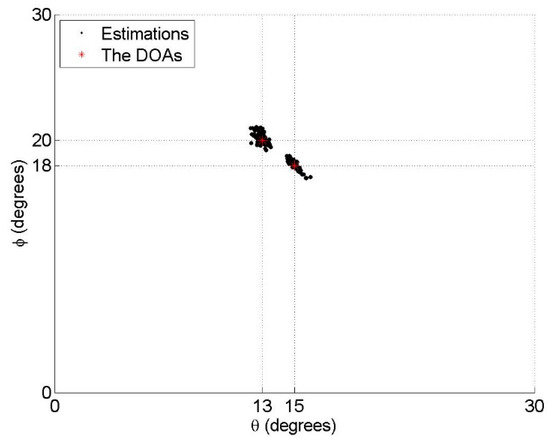
Figure 5.
Estimation results of the proposed method, where 100 Monte Carlo trials are carried out.
6.3. RMSE vs. SNR and Snapshots
A source with the impinging direction and polarization parameters is taken as an estimated example. Figure 6 plots the RMSE of the DOA estimates as the function of SNR with and . Figure 7 plots the RMSE of the polarization parameter estimates versus the SNR with and . From Figure 6 and Figure 7, one can find that in all cases the proposed model with N = 6 outperforms the one in [19] and is very close to the benchmark with N = 12.
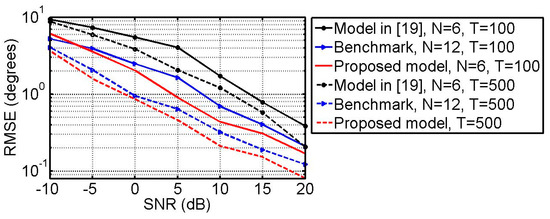
Figure 6.
RMSE of the DOA estimates versus SNR with T = 100 and T = 500.
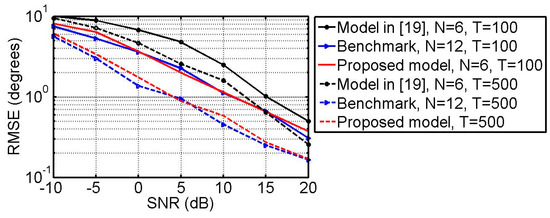
Figure 7.
RMSE of the polarization parameter estimates versus SNR with T = 100 and T = 500.
6.4. Detection Performance
In the following simulation, the source number detection performance of the models is investigated. Two sources with , , and () are taken into consideration. The detection accuracy is defined as , where is the trial number, and is the number of times when the detected source is true. In this example, . The probability of detection versus SNR with and are plotted in Figure 8. One can see from Figure 8 that the detection performance is improved when the SNR and snapshots are increased. In addition, it can also be seen that the proposed method considerably outperforms the one in [19] and performs very close to the benchmark.

Figure 8.
Probability of detection versus SNR with T = 100 and T = 500.
6.5 RMSE vs. N
What follows, we will compare the three methods by studying the relationships between the RMSEs and the number of physical vector sensors (i.e., N). The simulation conditions are the same as the example 6.3 except that SNR = 15 dB and N ranges from 4 to 12. The DOFs of the three models versus N are shown in Figure 9. Figure 10 shows the RMSEs of the angle estimates versus N. Figure 11 gives the RMSEs of the polarization parameter estimates versus N. From Figure 9, Figure 10 and Figure 11, one can find that in all cases the method in [19] can provide more DOF than the benchmark while the estimation performance of the benchmark is better than that of the method in [19]. It can also be seen that the proposed method surpasses both of them on the DOF and estimation performance.
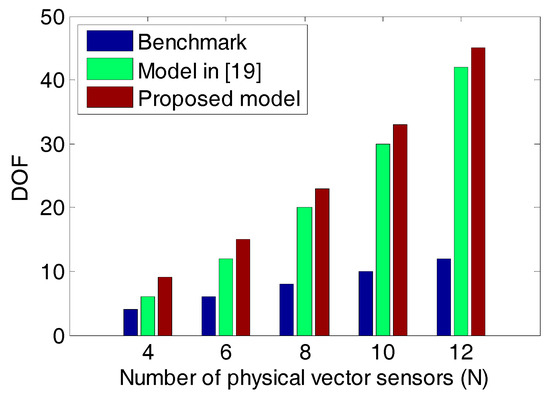
Figure 9.
DOF vs. N.
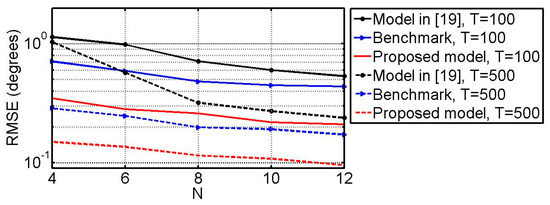
Figure 10.
RMSE of the DOA estimates vs. N.
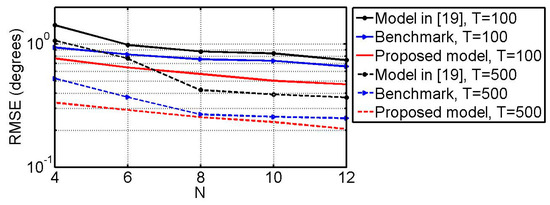
Figure 11.
RMSE of the polarization parameter estimates vs. N.
6.6. Runtime vs. N
As mentioned in [24,26], the computation complexity of the PARAFAC decomposition–based method involves many iterations and largely depends on the received data. Hence, the CPU running time of the proposed method is provided as a reference in this example. All of the compared methods here are implemented in MATLAB R2011a using a PC with Inter(R) Core(TM) i7-6500U CPU @2.50 GHz and 8 G RAM. The simulation conditions are the same as those of example 6.5. All of the simulation results are obtained via 100 Monte Carlo trials. Note that the angular resolution of the benchmark and the method in [19] is fixed to . The running time for all of the compared methods with respect to N is presented in Figure 12. From Figure 12, we can see that for each method the number of snapshots (i.e., T) does not have much affect on the running time. It can also be seen that the proposed method takes the least time for all of the cases.
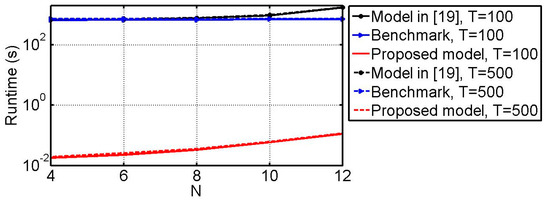
Figure 12.
Runtime versus N.
7. Conclusions
In this paper, a novel PARAFAC model for processing the nested array with N vector sensors, each of which contains M components, has been proposed. By dividing the nested vector-sensor array into a series of nested scalar-sensor subarrays and using the autocorrelation matrices of their measurements and cross-correlation matrices among them, the difference co-array of the original nested vector-sensor array is described as a PARAFAC model corresponding to a virtual ULA with vector sensors and M snapshots. Hence, the proposed model can fully exploit all the measurements of the difference co-array, and allows one using the PARAFAC decomposition to achieve the source localization and polarization estimation efficiently. As demonstrated by simulation results, the proposed model can achieve a better estimate performance efficiently and resolve slightly more sources than the reported ones in the literature.
Author Contributions
Investigation, W.R. and D.L.; Writing—original draft, W.R.; Writing—review & editing, J.Q.Z.
Funding
This research was funded by the National Natural Science Foundation of China (61571131, 61741405 and 61401188), Natural Science Foundation of Jiangxi Provincial Department of Education, China (GJJ170975), and Natural Science Foundation of Jiangxi, China (20171BAB212004).
Conflicts of Interest
The authors declare no conflict of interest.
References
- Nehorai, A.; Paldi, E. Acoustic vector-sensor array-processing. IEEE Trans. Signal Process. 1994, 42, 2481–2491. [Google Scholar] [CrossRef]
- Nehorai, A.; Paldi, E. Vector-sensor array-processing for electromagnetic source localization. IEEE Trans. Signal Process. 1994, 42, 376–398. [Google Scholar] [CrossRef]
- Yuan, X. Estimating the doa and the polarization of a polynomial-phase signal using a single polarized vector-sensor. IEEE Trans. Signal Process. 2012, 60, 1270–1282. [Google Scholar] [CrossRef]
- Zhong, X.H.; Premkumar, A.B. Multiple wideband source detection and tracking using a distributed acoustic vector sensor array: A random finite set approach. Signal Process. 2014, 94, 583–594. [Google Scholar] [CrossRef]
- Zhao, A.; Bi, X.; Hui, J.; Zeng, C.; Ma, L. An improved aerial target localization method with a single vector sensor. Sensors 2017, 17, 2619. [Google Scholar] [CrossRef] [PubMed]
- Gu, C.; He, J.; Li, H.T.; Zhu, X.H. Target localization using mimo electromagnetic vector array systems. Signal Process. 2013, 93, 2103–2107. [Google Scholar] [CrossRef]
- Le Bihan, N.; Miron, S.; Mars, J.I. Music algorithm for vector-sensors array using biquaternions. IEEE Trans. Signal Process. 2007, 55, 4523–4533. [Google Scholar] [CrossRef]
- Liu, L.; Wang, L.; Zhang, Z. Vector-sensor-based signal parameter estimation by exploiting cpd of tensors. IEEE Sens. Lett. 2018, 2, 1–4. [Google Scholar] [CrossRef]
- Pal, P.; Vaidyanathan, P.P. Nested arrays: A novel approach to array processing with enhanced degrees of freedom. IEEE Trans. Signal Process. 2010, 58, 4167–4181. [Google Scholar] [CrossRef]
- Zhao, Y.H.; Zhang, L.R.; Gu, Y.B. Array covariance matrix-based sparse bayesian learning for off-grid direction-of-arrival estimation. Electron. Lett. 2016, 52, 401–402. [Google Scholar] [CrossRef]
- Pal, P.; Vaidyanathan, P.P. Nested arrays in two dimensions, part I: Geometrical considerations. IEEE Trans. Signal Process. 2012, 60, 4694–4705. [Google Scholar] [CrossRef]
- Alinezhad, P.; Seydnejad, S.R.; Abbasi-Moghadam, D. Doa estimation in conformal arrays based on the nested array principles. Digit. Signal Process. 2016, 50, 191–202. [Google Scholar] [CrossRef]
- Niu, C.; Zhang, Y.S.; Guo, J.R. Interlaced double-precision 2-d angle estimation algorithm using l-shaped nested arrays. IEEE Signal Process. Lett. 2016, 23, 522–526. [Google Scholar] [CrossRef]
- Zhang, L.; Ren, S.; Li, X.; Ren, G.; Wang, X. Generalized l-shaped nested array concept based on the fourth-order difference co-array. Sensors 2018, 18, 2482. [Google Scholar] [CrossRef] [PubMed]
- Yang, J.; Liao, G.S.; Li, J. Robust adaptive beamforming in nested array. Signal Process. 2015, 114, 143–149. [Google Scholar] [CrossRef]
- Han, K.Y.; Nehorai, A. Wideband gaussian source processing using a linear nested array. IEEE Signal Process. Lett. 2013, 20, 1110–1113. [Google Scholar]
- Han, K.Y.; Nehorai, A. Nested array processing for distributed sources. IEEE Signal Process. Lett. 2014, 21, 1111–1114. [Google Scholar]
- Han, X.; Shu, T.; He, J.; Yu, W. Polarization-angle-frequency estimation with linear nested vector sensors. IEEE Access 2018, 6, 36916–36926. [Google Scholar] [CrossRef]
- Han, K.; Nehorai, A. Nested vector-sensor array processing via tensor modeling. IEEE Trans. Signal Process. 2014, 62, 2542–2553. [Google Scholar] [CrossRef]
- Kolda, T.G.; Bader, B.W. Tensor decompositions and applications. SIAM Rev. 2009, 51, 455–500. [Google Scholar] [CrossRef]
- Boizard, M.; Ginolhac, G.; Pascal, F.; Forster, P. Low-rank filter and detector for multidimensional data based on an alternative unfolding hosvd: Application to polarimetric stap. EURASIP J. Adv. Signal Process. 2014, 2014, 119. [Google Scholar] [CrossRef]
- Li, Y.; Zhang, J.Q. Mode-r subspace projection of a tensor for multidimensional harmonic parameter estimations. IEEE Trans. Signal Process. 2013, 61, 3002–3014. [Google Scholar] [CrossRef]
- Sorensen, M.; De Lathauwer, L. Blind signal separation via tensor decomposition with vandermonde factor: Canonical polyadic decomposition. IEEE Trans. Signal Process. 2013, 61, 5507–5519. [Google Scholar] [CrossRef]
- Dong, Y.Y.; Dong, C.x.; Liu, W.; Chen, H.; Zhao, G.q. 2-d doa estimation for l-shaped array with array aperture and snapshots extension techniques. IEEE Signal Process. Lett. 2017, 24, 495–599. [Google Scholar] [CrossRef]
- Pal, P.; Vaidyanathan, P.P. Nested arrays in two dimensions, part II: Application in two dimensional array processing. IEEE Trans. Signal Process. 2012, 60, 4706–4718. [Google Scholar] [CrossRef]
- Rao, W.; Li, D.; Zhang, J.Q. A tensor-based approach to l-shaped arrays processing with enhanced degrees of freedom. IEEE Signal Process. Lett. 2018, 25, 1–5. [Google Scholar] [CrossRef]
- Kah-Chye, T.; Kwok-Chiang, H.; Nehorai, A. Linear independence of steering vectors of an electromagnetic vector sensor. IEEE Trans. Signal Process. 1996, 44, 3099–3107. [Google Scholar] [CrossRef]
- Hochwald, B.; Nehorai, A. Identifiability in array processing models with vector-sensor applications. IEEE Trans. Signal Process. 1996, 44, 83–95. [Google Scholar] [CrossRef]
- Lathauwer, L.D. Decompositions of a higher-order tensor in block terms—Part I: Lemmas for partitioned matrices. SIAM J. Matrix Anal. Appl. 2008, 30, 1022–1032. [Google Scholar] [CrossRef]
- Nion, D.; Sidiropoulos, N.D. Tensor algebra and multidimensional harmonic retrieval in signal processing for mimo radar. IEEE Trans. Signal Process. 2010, 58, 5693–5705. [Google Scholar] [CrossRef]
- He, Z.; Cichocki, A.; Xie, S.; Choi, K. Detecting the number of clusters in n-way probabilistic clustering. IEEE Trans. Pattern Anal. Mach. Intell. 2010, 32, 2006–2021. [Google Scholar] [PubMed]
- Cichocki, A.; Mandic, D.P.; Phan, A.H.; Caiafa, C.F.; Zhou, G.X.; Zhao, Q.B.; De Lathauwer, L. Tensor decompositions for signal processing applications. IEEE Signal Process. Mag. 2015, 32, 145–163. [Google Scholar] [CrossRef]
© 2018 by the authors. Licensee MDPI, Basel, Switzerland. This article is an open access article distributed under the terms and conditions of the Creative Commons Attribution (CC BY) license (http://creativecommons.org/licenses/by/4.0/).